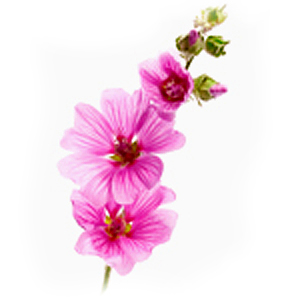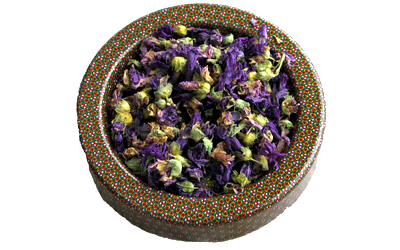No products
Mallow bloom - 50g
Mallow (Malva mauritiana) bloom (Flos malvae) is used in catarrh of the upper respiratory tract, laryngitis, pharyngitis and in inflammation of the stomach lining as well...
![]()
Content |   |
Binomial nameMalva mauritiana Commonly called (often known as)Mallow StorageStore in a dry place at a temperature up to 25°C |
Description of herb
Moorish mallow (Malva mauritiana) - a biennial and perennial plant, up to 1.5 m high with large, violet-blue flowers (Flos Malvae), which are used for medicinal purposes after drying.
It occurs in the Mediterranean, both in southern Europe and in North Africa.
The botanical name Malva dates back to antiquity. It is derived from the Greek moloché, malaché, malassó - I soften it, which marked its healing properties resp. mucus content. Mauritiana - because it originally grew wild in Mauritania.
According to the finding of seeds in Lusatia from the last ice age, it is possible to conclude that Mallow has been used medically for a very long time. Ancient physicians commonly prescribed it internally and externally.
Healing effects
In folk medicine, the drug is used for bloating and wound dressings. Aromatic, detoxifying and antiseptic effects have been demonstrated here.
The mucilages contained in the flowers of Moorish Mallow have a protective effect on mucous membranes damaged by inflammation or infection and accelerate the regeneration processes in the tissues.
The drug is used in catarrh of the upper respiratory tract, laryngitis, pharyngitis and also in inflammation of the gastric mucosa.
Externally
serves for the preparation of herbal emollient compresses, as an additive to mouthwashes and gargles supporting the healing of inflamed mucosa in the oral cavity. It is used for bloating, for washing and dressing for wounds, in the treatment of cellulite and for shin ulcers.
Internally
The most significant are the effects of mucus, which can cover the mucous membranes and create a protective coating on them, thus accelerating their healing. Mallow has a beneficial effect on the respiratory tract, so it is used for colds and inflammation of the upper respiratory tract and for bronchial catarrh, asthma and bronchitis.
We will especially appreciate it for a painful, dry and irritating cough. Because it behaves the same way in the digestive tract, it can also be used to relieve stomach and intestinal problems or as a mild laxative. Drugs from Mallow are mainly mucous preparations, have an anti-inflammatory, slightly astringent effect and dissolve mucus.
All substances contained in Moorish Mallow are non-toxic, so they are also suitable for children and nursing mothers.
The anthocyanin dye malvidin is now used to color food products.
Active substances
Mallow flower has a high content of mucus, tannins, anthocyanins (dyes), organic acids (including ascorbic), essential oils and other compounds, which together form a complex of substances that have a beneficial effect on our body.
Properties
Aromatic, detoxifying, antiseptic, mucilaginosum, astringent.
Recommended at
- flatulence
- cold
- inflammation of the upper respiratory tract
- asthma
- bronchitis
- laryngitis
- pharyngitis
- inflammation of the gastric mucosa
- inflamed mucous membranes in the oral cavity
- cellulite treatment
- shin ulcers
Preparation and dosing
TEA
Preparation: One teaspoon, pour 250 ml of boiling water and leave to infuse for 15 minutes in a covered container.
Dosing: Drink it warm, to support coughing in inflammation of the upper respiratory tract twice a day.
Side effects
Mallow has no side effects and is therefore also suitable for children and nursing mothers.
REMEMBER: Tell all your health care providers about any complementary health practices you use. Give them a full picture of what you do to manage your health. This will help ensure coordinated and safe care.

